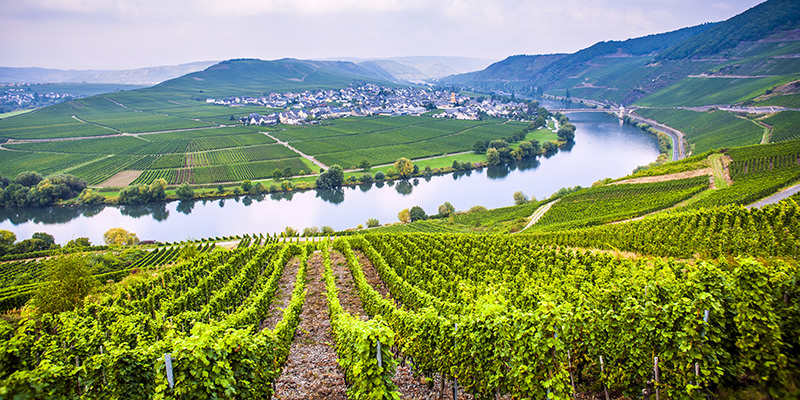We get it — wine regions are special, and not just because the fruits of their labor have lent a happy buzz to imbibers for millennia. A wealth of intricate details combine to make these hallowed regions perfect for grape growing. Sunshine, soil, and water are the basic ingredients, but the rivers that criss-cross most famed areas also play a critical and oft-overlooked role.
Beyond providing postcard-worthy backdrops, these curvaceous flows moderate severe climates across Europe and the New World, which is important because most wine regions exist in harsh, or marginalized areas. From the chilly Mosel Valley to the scorching Ribera del Duero in central Spain, vines thrive thanks to the influence of major rivers, and it’s not because they provide irrigation. In fact, it’s likely that without these rivers the vines there would produce average swill instead of legendary elixirs.
If not irrigation, then what? Drinkers have chemistry to thank in this case. Because liquid water maintains its temperature longer than air, rivers are able to act as both heat reservoirs and cooling agents in the valleys they’ve carved over thousands of years. This science is the same reason outdoor pools stay warm longer than the air after sunset, and why seaside areas have more consistent temperatures than their nearby inland counterparts.
When it comes to fine wine, these moderating influences are paramount because they allow grapes to ripen while retaining vital acidity, either by adding heat or cold. A combination of sugar and acid in grapes is what allows a finished wine to taste “balanced,” i.e. not overly dominated by oak, fruit flavors, astringent tannins, or tart acidity. When most professionals analyze a wine — from a celebrated locale or otherwise — this sense of balance and terroir is what they’re searching for, and what gives a wine a high value, and higher price on shelves and menus. A prime location near a major river makes this balance easier to achieve, since rivers tame climates and limit vintage variation as a result. In short, rivers counteract the most brutal elements of a region’s climate and give winemakers better crops to work with every season.
In the ancient Mosel region of Germany, for example, the Mosel river acts as a space heater during cold nights and reflects sunshine and heat during chilly days. With average summer temperatures of just 64 degrees, this heat is critical to ripening the world’s most-prized Rieslings. In fact, the river’s influence makes the Mosel Valley Germany’s warmest regions despite its Northerly location.
In the Duero valley on the Iberian peninsula, rivers fulfill the opposite function by cooling hot, arid vineyards responsible for exalted Tempranillos and rich red blends. Especially in the Ribera del Duero region of central Spain, overnight temperature drops in the river valley (known affectionately as diurnal shifts) prevent the grapes from continuing to ripen overnight, and losing the acid that keeps even the boldest reds refreshing and extraordinarily valuable.
Wines from regions sans rivers aren’t necessarily plonk, but they rarely command the prices and garner the prestige of their more picturesque counterparts. In dry areas like California’s central Valley, Portugal’s Alentejo, or La Mancha in Spain, overripe grapes are a consistent obstacle to crafting quality wines. Likewise in cold regions like the Niagara Peninsula or British Columbia, simply ripening grapes in the short growing season is painstakingly difficult.
Across the board, respected wine regions have rivers: Bordeaux, Loire, Mosel, Douro, Napa, Rhone, Rioja, and Margaret River. Historically, strategic riverside locations ensured access to markets for finished wines in addition to climatic benefits. Even with modern transportation advances, one thing is for certain — vines aren’t planted in river valleys for the views.

